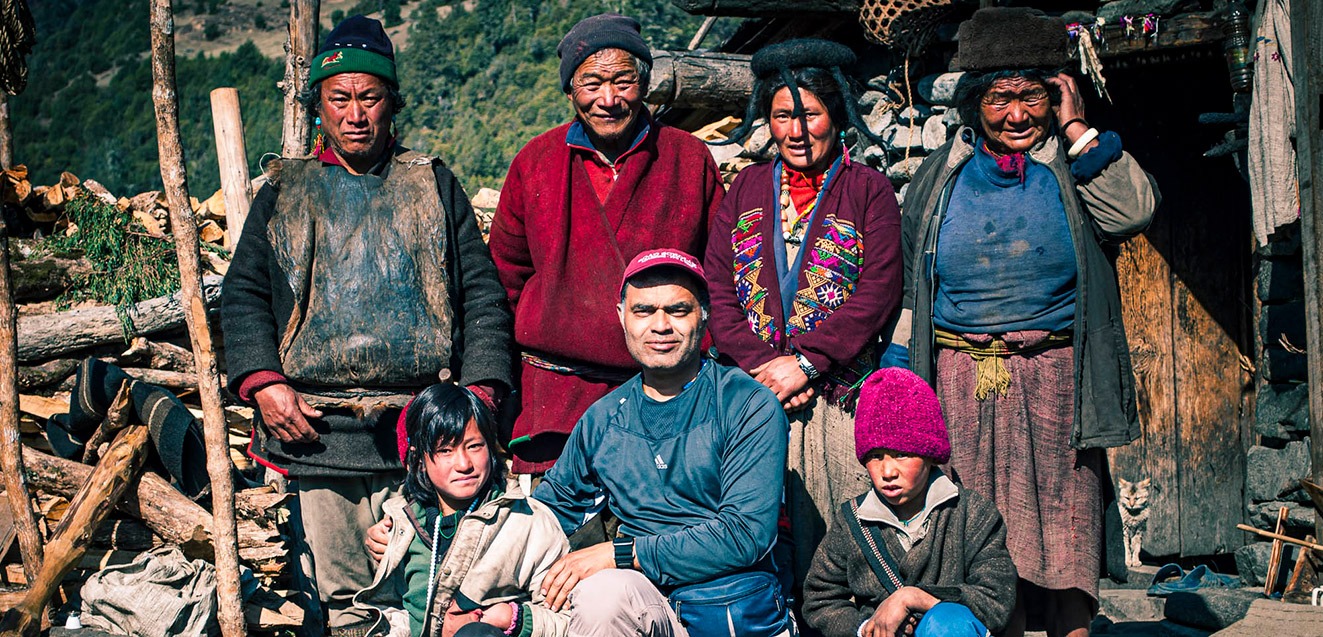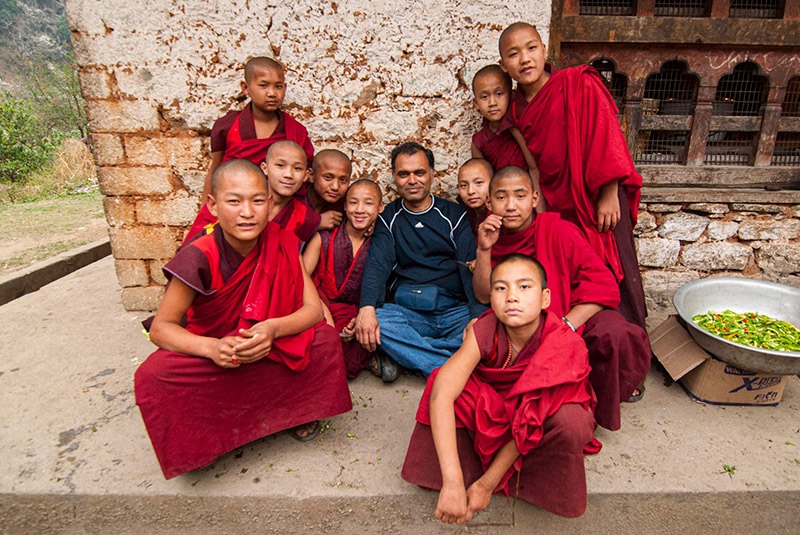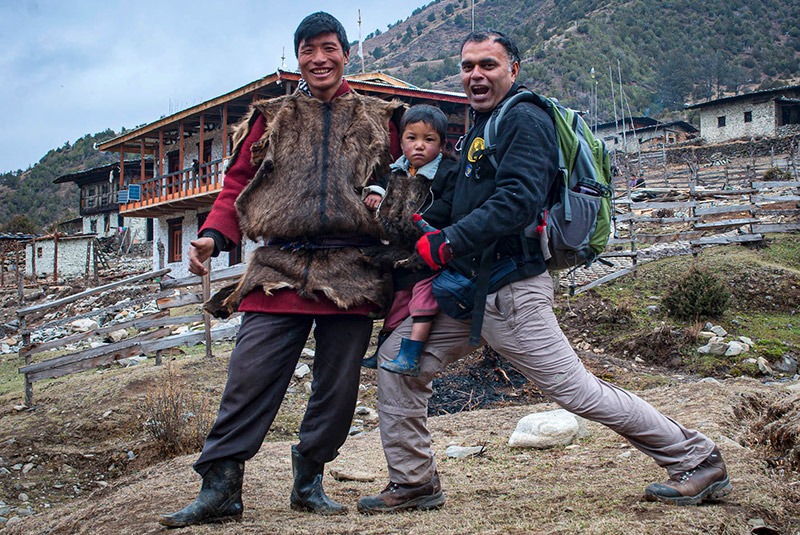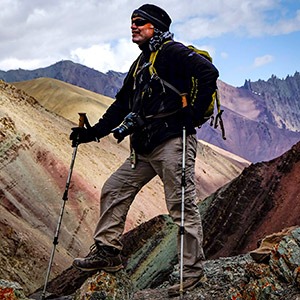Bringing History & Culture Alive: A Conversation with Manoj Sharma

I love conversing with GeoEx’s trip leaders. These conversations are like life-freshening windows onto the wider world—a gift that is especially precious right now when the wider world is mostly beyond my reach.
Most recently, I had the pleasure of interviewing esteemed trip leader and brilliant photographer Manoj Sharma, who, over the past two decades, has explored more than 300 destinations in India, Tibet, Nepal, and Bhutan.
I hope you enjoy our interview!
Don George: When and how did you become a trip leader?
Manoj Sharma: My first commercial trip leading was in July 1987 as an assistant trip leader for a BBC filming group. It was a good three-week trek in the high Himalayas and it opened my eyes. Until that time, I had been a trek leader for a non-profit trekking club. The quality of food, equipment, crew, and planning for the BBC trip was on a totally different plane. The following week, I independently led my first commercial trek, which was a Spanish trekking group, trying to keep in mind the high-quality standards that had been shown to me.
What was your original motivation to lead treks?
Long story alert!
My father, who was in the railways, decided to take our whole family to the Himalayan hill station of Shimla, the erstwhile summer capital of British India. I was 5 years old and we traveled for six hours in a fascinating toy train (it still runs), passing through mist-covered Himalayan mountains. It was ethereal to watch clouds lower than me as the train chugged along mountains, valleys, and rivers. The train passed through 103 tunnels and stopped at 17 stations. Along the way, we would get off and buy cookies and tea, etc. I got introduced to the engine driver, who was wearing a handsome uniform and who showed me his toy engine and how it worked.
At the end of this first mountain journey, my career plan was settled. When I grew up, I was going to be the railway engine driver on this toy train and I would show other kids how the train runs!
Well, life did not turn out that way—but my fascination with the mountains remained.
We did more trips to the Himalayas as a family, going to Kashmir and Mussoorie, etc., but my dream of doing a hard trek or a camping trip never worked out as there was almost no trekking equipment easily available in India at that time.
That opportunity came in middle school, when our school opened an outward-bound program. Soon, after a few camping trips, I was spending so much time in the back office, voluntarily cleaning and repacking camping gear, that my teachers started looking at me as an assistant on these trips. Voila! Suddenly I was not required to pay full fee for my next camping trip as I was an assistant leader.
During college, I got into a bigger, pan-India trekking and mountaineering club called Climbers and Explorers Club. This was a fast-growing club with over 2,000 active members and a huge number of institutional members. They were operating more than 50 trekking and mountaineering programs a year and had a great amount of trekking and climbing equipment.
And again, after my first trip as a participant, I soon started spending most of my evenings at the club doing a good amount of back-office work as well as meeting famous climbers of India. Being treated as an asset by the club was a great feeling and soon I was part of the trek planning. Trek leading was a natural next step. I led over 10 good treks in the Himalayas for participants who were from all over India.
There were many senior members who were leading treks on a commercial basis and after college, when I was looking for a job, their recommendation came handy.
Two days after starting my job, I was out on my first commercial trip, leading as an assistant.
That’s a great story! Can you briefly summarize your experience as a trip leader—that is, where you have led trips in the past, and for how many years?
I have been leading trips now for a good 33 years and have done more than 200 trips for clients from North America, Europe, and Japan. I have done multiple treks and classical trips, including photography tours in the Himalayan region of Ladakh, Zanskar, Kashmir, Spiti, Garhwal, Kumaoun, Sikkim, Arunachal Pradesh, central and eastern Tibet, Nepal, and western, central, and eastern Bhutan.

Other than the Himalayas, I have done extensive trips in all the 29 states of India as well as most areas of Sri Lanka and Bangladesh.
Many of these trips were the first of their kind since the areas had been closed to tourism before. These include the overland trip to Ladakh from Himachal Pradesh, the Spiti Valley overland tour, and the Arunachal Pradesh tribal tour.
What an amazing career and what a tremendous travel resume! As someone who has led so many trips, to your mind, what are the qualities of a great trip leader?
A good trip leader is like a local who loves his city. And his guests are like his family friends who are visiting him. He wants to show them the best of what is available in his city, from the well-known to the quirky little corners that only a local would know.
As a trip leader, you must have confidence in the trip that you are about to lead. You must have a sense of the fascinating sights that await you and your travelers. Or of what to expect, if something is unknown even to you.
A trip leader must enjoy the trip himself/herself, and have the ability to take along the whole group on that same path of enjoyment.
The fact that so many clients and back-office team members have put their faith into your ability to make the trip a success is a good motivator. Knowledge of the area, getting the best out of your crew, flexibility, a sense of adventure, humor, and the ability to address the various needs of your clients, these all make for a good trip leader.
What are your goals in showing travelers the places you love?
My goal is to bring alive the era and the culture of what we are witnessing. To have a story going in terms which are understandable to my travelers. In most areas I have visited, there are amazing historical anecdotes associated with them and to showcase those to my guests in an interesting way is truly satisfying.
For you, what are the rewards of leading trips?
I consider myself a traveler first, middle, and last. So, the fact that I get to travel—to me, that is the single most important reward. So many times I have stood at some incredible site somewhere, wondering that I am getting paid for doing something that I would be more than happy to be doing for free!
The other, very important reward is that I end up meeting so many clients who share the same philosophy, and I deeply enjoy their company and they enjoy mine. As the saying goes, you don’t travel to reach a destination. Travel is the destination.
What’s a favorite story that shows the effect a good trip leader can have on a trip?
In a group trip, one major issue that can derail a most beautifully crafted tour is the group dynamism. Different members, who did not know each other before the trip, may have different expectations and needs.
As a trip leader, the one thing that you don’t want to do is to try to herd all your travelers as one.
I remember a hard, high-altitude trek in Sikkim that was going over rough terrain, snow, ice, and slush. On the sixth day of the trek we were supposed to reach the Goecha La mountain pass at 16,302 feet, which sits at the base of 28,334-foot Mount Kanchenjunga, the third highest mountain in the world.
This required us to wake up at 3 a.m. and start our hike in pitch darkness. The expected time to complete our hike, including the return, was about 14 hours. Everybody knew about this day from the start as it was part of the program, but of course everybody was in nervous anticipation throughout the early part of the trip.
From the first day of the trek, it was obvious that some clients were very fit and nimble on the mountains and others were slow but steady. This was not a problem for me as I had enough staff with me, so on that sixth day, I gave one of my crew as a guide to the fast members, with clear instructions that they should wait for the rest of the group at our lunch spot and that, after lunch, no one should go ahead of the pack animal train.
At first this was perfect for everybody, but soon the mumbling started. The fast group had a doctor and it was suggested that in order to ensure that no members of the group got high altitude sickness, I, as trip leader, should consider keeping the slow members at lower altitudes only and not let them trek to the higher grounds.
I understood their concern, but based on my many years of experience at high altitude—per my last calculation, I have spent over three years in a mountain tent above 10,000 feet!—and having done many first responder courses which dealt expressly with mountain sickness, I did not think that any such action was required.
The slow members were, well, slow, but that was not a negative thing as everybody was still walking as per our planned itinerary. It is just that the fast members were fast!
As the discussions got more animated, it became clear to me that I had to humor them both. So I told the fast group that I would definitely consider the suggestion to keep slow members at lower altitudes if they showed signs of any altitude sickness, but not before. And I told the slow members that they were walking at a pace which was the same as more than 90 percent of my previous clients, so until or unless they felt any discomfort, they were good to go.
I am the expert and the decision will be mine alone, I said. And in any case, we will make the decision when we need to and not a moment before.
As it turned out, everybody except one member made it to the Goecha La pass. That one member, who was from the slower group, voluntarily decided to give the hard day a miss, but was very glad that she still could reach as high as she did.
At the end of the day, every member agreed that I did not get caught in the tension between the two groups and that my open but firm flexibility and approachability had allowed each member to reach their individual goal, while maintaining all the safety requirements and keeping the group dynamics going. That was very satisfying.
What’s your favorite experience in the places where you lead GeoEx travelers?
My best experiences are when my GeoEx clients and the local communities get to meet each other in a friendly setting and to exchange ideas. To watch as two remote cultures meet is, in itself, such an uplifting experience.
Sitting in a local tribal family home, sharing pictures of grandchildren or comparing jewelry or tattoos, or listening to wedding stories—these are the ultimate travel experience.

I agree completely! I love it when that kind of cultural interaction occurs before my very eyes. I can see the bridges of connection being built! In all your trips, what’s your best memory?
Once, a group I was leading in southern Tibet took a left turn towards the Rongbuk monastery—and suddenly, there it was: “a prodigious white fang, an excrescence from the jaw of the world,” as Mallory so memorably described it. Mount Everest, at 29,200 feet the highest mountain in the world, was right in front of us on a clear-sky day!
The memory of that first full view of the mountain still gives me goosebumps. I had a satellite phone and I quickly called my wife back in Delhi to share what I was seeing. That day will remain etched in my mind forever.
Wow! What an amazing experience—now it will be etched in my mind too! The story you just told may be an answer to this next question too, but why do you love what you do?
I love the momentum, that feeling that I am going somewhere. And that sense of responsibility which makes me showcase the best of what the destination has to offer to my clients who have put so much faith in me.
What is your philosophy of trip leading?
I believe that a trip leader must love the trip that he is leading. Travel liberates me, and it is deeply rewarding that I can share the love and liberation I feel with the people who join me.
Do you have any last words for GeoEx travelers who might want to travel on one of your trips?
Come join me on my Ladakh trips in the summer of 2021! I was involved in creating these trips and I love them so much—I am sure you will love them too when you travel with me!

* * * * *
Do you have a question for Manoj Sharma? Or a favorite travel memory you’d like to share? Please add your questions or reflections below. It’s always a delight to hear from you!
Thank you so much for providing this interview with the “Mighty Manoj” as he was named by our group. We – a group of 6-8 old and new friends – meet and were inspired by Manoj on two trips in India. Manoj led us on a 2004 tour of Southern India — Kochi, Kerala, Chennai, and a first-of-its kind tent camp for a festival of the moon which included the most amazing midnight parade of elephants. Something none of us will ever forget. And, we were back again in 2006 when Manoj took us to Ladakh. Again, many unforgettable sights… Read more »
Manoj, its David Beard, from Tibet circa 2004! Wow!!
I still tell stories of our travels. You were an amazing guide. now its time for our own stories…
My wife Susan and I are planning trips back to Bhutan, maybe Assam, maybe Sikkim, all inspired by you.
I’d love to catch up at some point. Send me an email when you can. dbeard@gmail.com
What a wonderful philospphy of leading a trekking/travel group. I was very impressed with Manoj and his impressive talents. I am looking forward to June ’21 Ladakh trip with Manoj Sharma. I hope Covid 19 restrictions would be long gone by then. I love to photograph along the way. It is great to have a good photographer and leader with me.
I travelled with Manoj in India in 2004. He is a superb guide. Without equal.
I so agree that wonderful memories and bridges are made through cultural and generational interactions. I had the opportunity to participate in a Girl Guide/Girl Scout program in India several years ago.
Taking a local train from Mumbai to Pune; traveling in a rickshaw; visiting a family home to share a meal; exploring the markets; having a sari made; visiting temples; and being part of a day camp for local Boy Scouts and Girl Guides are memories vividly embedded in my mind. The experiences shared with others of another culture truly opens the mind.
Nice to read the interview with Manoj. He is fun to travel with even when not at altitude

